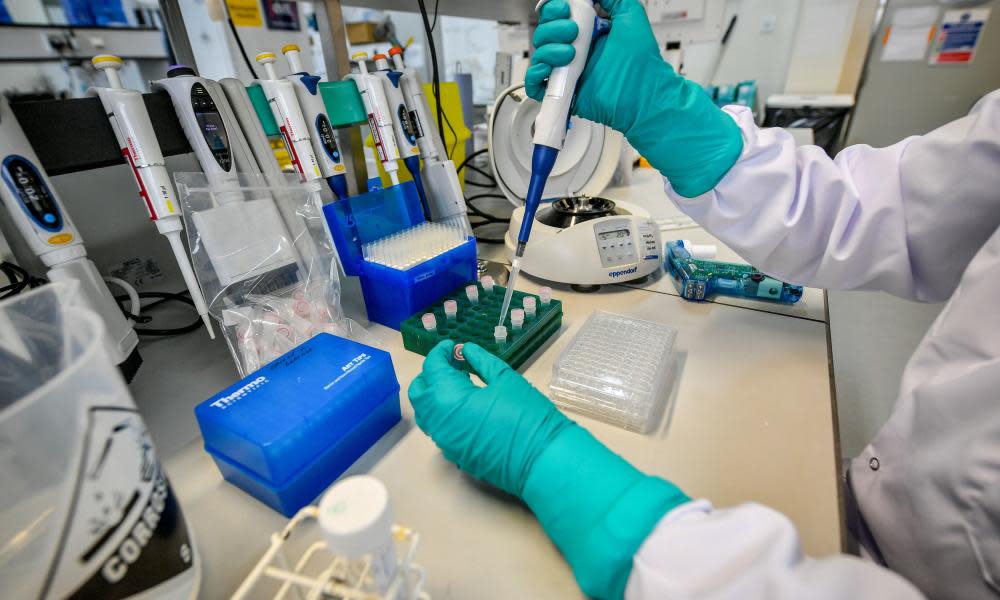Dangerous incidents at UK laboratories ‘potentially exposed staff to Covid’

Dangerous incidents at UK laboratories, hospitals and Covid test centres potentially exposed staff to coronavirus and other hazards over the course of the pandemic, according to official reports obtained by the Guardian.
Many involved leaks and spillages of virus-laden fluids, but investigations also took place into a flood at an animal facility housing Covid-infected monkeys, mix ups that led scientists to work on live virus by mistake and a researcher being bitten by an infected ferret.
The Health and Safety Executive recorded at least 47 “dangerous occurrences” involving coronavirus at UK research facilities, hospitals and Lighthouse labs over the course of the pandemic. Reports from 37 cases were released to the Guardian under the Freedom of Information Act. The rest were withheld because of ongoing investigations.
The reports reflect the immense pressure that scientists, healthcare workers and staff at Lighthouse labs came under as Covid swept through Britain. Researchers’ hours soared as they raced to understand the lethal new virus. Meanwhile, NHS staff and specialists rapidly deployed to test centres were pushed to breaking point.
Common mishaps were leaks, spillages and splatters of virus-laden fluids, some at the hands of humans, others at the arms of robots, prompting swift evacuations and clean-up operations by biohazard teams. A recurring issue at the Lighthouse laboratories arose from swabs in home test kits not snapping properly, leading people to force them into sample tubes before screwing the caps on. This created what the HSE called a “spring coil” which turned swabs into “projectiles” when the vials were uncapped for testing.
On several occasions, scientists worked on live virus without proper safety measures because they believed the virus had been killed, while in other incidents, Covid positive test samples were transported without correct precautions. According to HSE reports, two healthcare workers at a hospital in Chichester became infected with Covid after not wearing PPE, but there is no evidence lab staff caught the virus in work-related blunders. In most cases staff were wearing appropriate PPE.
The National Institute of Biological Standards and Control, operated by the UK medicines regulator, was investigated after a flood at an animal facility housing Covid-infected marmosets. The same lab was later found to have breached multiple safety regulations when researchers spotted water droplets on the lab bench and floor after heating Covid virus stock. The risk of exposure was deemed “extremely low”, but the HSE found the lab fell short on planning, control and monitoring of Covid work, failed to provide sufficient information and training to allow safe handling of the virus, and failed to hold appropriate safety drills.
Public Health England’s Porton Down laboratory, which also performed crucial work in the Covid pandemic, was ordered to improve safety after a researcher was bitten by an infected ferret. An investigation into the incident in May 2020 found the animal sliced through the scientist’s protective clothing and drew blood, leading managers to send the researcher home to care for the wound and self-isolate.
The HSE served a “Crown improvement notice” on the Wiltshire lab and asked managers to beef up safety across several facilities. But with staff “over-stretched” due to “a doubling of workload”, the case was not closed for a year.
Allen Roberts, a deputy director at Porton Down for the UK Health Security Agency, (formerly Public Health England), said: “We take the safety of our lab scientists very seriously. The actions raised to us by the HSE have been actioned which have helped further strengthen the robust systems and processes in place to ensure we continue to work safely and securely.”
A HSE spokesperson said the “very high level of control” in the sector was reflected in its good health and safety record. “Cases of mislabelling, or near misses, are extremely rare. There are strict requirements to report incidents and we also expect intelligence sharing across the sector,” they said.
Vincent Theobald-Vega, a former HSE inspector and director of the Safety 4 HEd consultancy, said biocontainment laboratories, the equipment used in them, and numerous safety protocols are designed to protect against the worst effects of any incidents. But for people at work in the labs, there are still risks, particularly from handling samples. “Research labs are generally much more dangerous environments than process labs where simple tests are undertaken in a process line environment,” he said.
“When these controls break down it is important that people understand what went wrong so that people can modify the processes and try to prevent the same situation developing next time round. This is the primary purpose of investigation in the health and safety community,” he added. “If organisations did not report we would all know much less about the ways that systems fail and the labs would be much less safe as a result.”
An MHRA spokesperson said staff safety was a top priority and that all near-misses or accidents were thoroughly investigated through internal incident investigation procedures to understand why they occurred.
“Following the two incidents related to emergency procedures referred to by HSE, all emergency scenarios have been reviewed and our training has been updated so staff can respond appropriately in emergency situations. These incidents were promptly addressed and did not pose any significant risk of harm to staff,” the spokesperson aid. “The breach of regulations has been fully addressed with changes made to the laboratory and the operating procedures for its use.”

 Yahoo Movies
Yahoo Movies 
